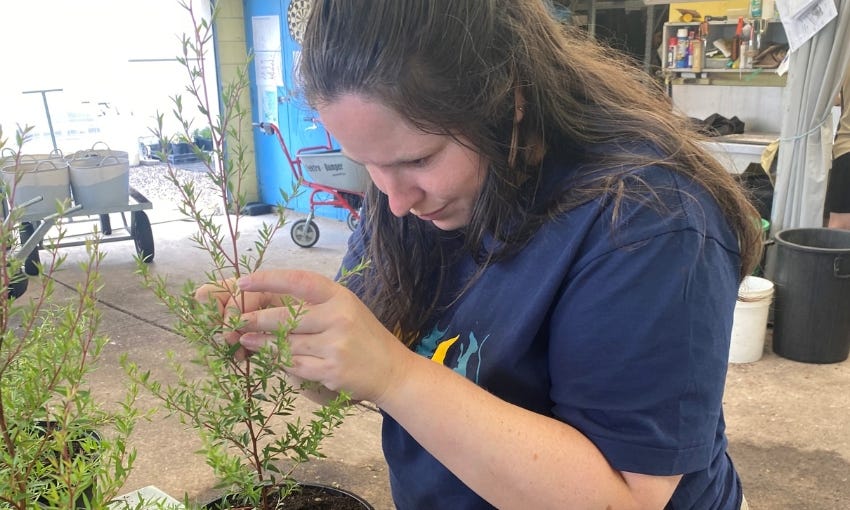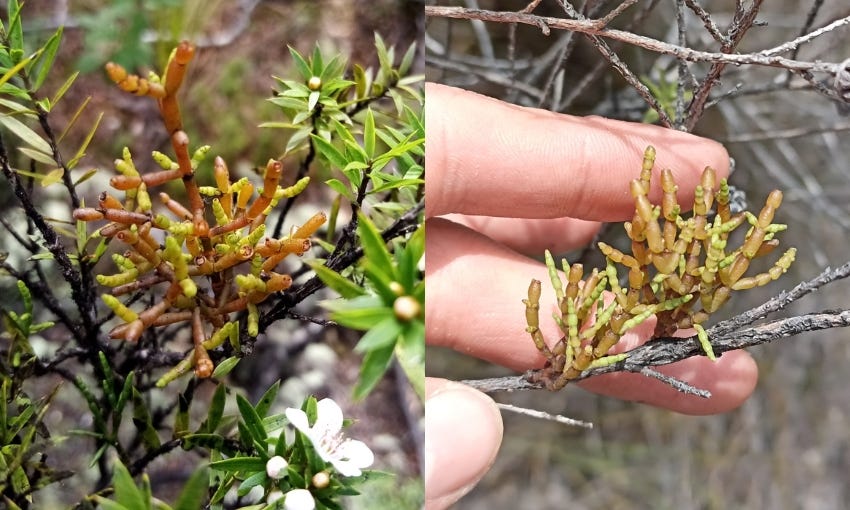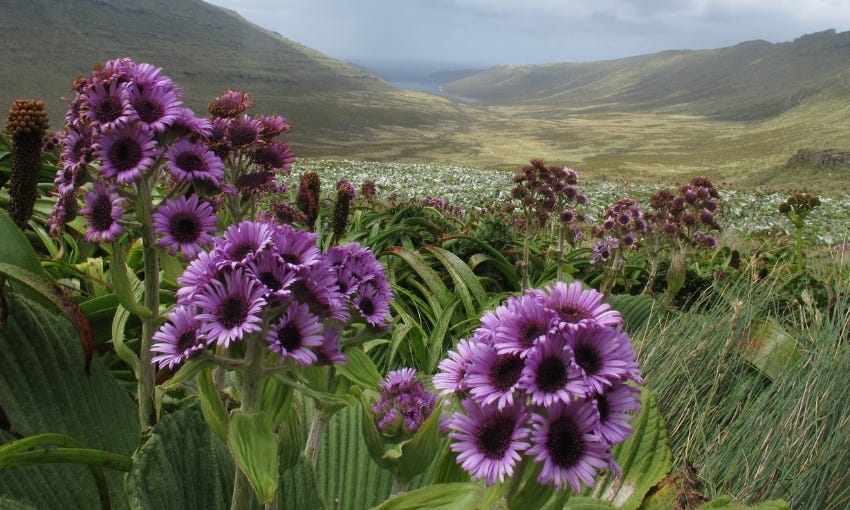A rescue plan for an oddball native plant
Behind the pretty flower beds at Auckland Botanic Gardens: conservation mahi for the region’s 357 threatened plants.
Kia ora, welcome to Future Proof. Thanks for joining me! This week: private jets, “munted” fish stocks, and changing how we use the land. But first: botanic gardens are more than just pretty flower beds.
Ella Rawcliffe carefully planting a mistletoe seed on mānuka. Image credit: Emma Simpkins.
At Auckland Botanic Gardens, conservation specialist Ella Rawcliffe has been trying to plant a seed that’s smaller than a grain of sand. She can’t embed it in soil – this plant doesn’t have roots. Instead, she smooshes it into the cradle of a mānuka branch, marking its location with a spot of correction fluid.
The seed – collected from a West Auckland park – will hopefully grow into the “nationally critical” dwarf mistletoe (Korthalsella salicornioides). This oddball plant has “succulent-like” twiggy appendages instead of leaves, and like all mistletoes, is a parasite, requiring a host to survive. Classified as “nationally critical”, it now needs us to survive too.
The dwarf mistletoe is not alone: 357 of the 800 native plants found in Auckland are threatened species, according to Auckland Council’s Environmental Services team. They’ve spent the past 18 months figuring out “what plants are where, and how threatened they are,” says Emma Simpkins, senior regional advisor flora.
The leafless native dwarf mistletoe growing on mānuka in the wild. Left image credit: titine via iNaturalist NZ (CC BY 4.0). Right image credit: Oscar Dove via iNaturalist (CC BY 4.0).
The plants in trouble “range from little grasses and herbs, through to trees,” says Simpkins. Some are threatened because their habitat is fragmented, or disappearing, or they’re now only found in a single location. Many face threats related to climate change, “which is gonna be pretty challenging for us to manage,” she says. That’s where botanic gardens come in: “Those plants can be looked after, while we figure out the best way to manage them in the wild.”
Two-hundred and twenty-four plant species are candidates for safekeeping at the botanic garden (through seedbanking or propagation, to safeguard their genetics) and work is under way to figure out top priorities. Rawcliffe and the team at the botanic garden, meanwhile, have a different challenge. “Most of these plants have never been grown before,” says Rawcliffe. “We’ve got to figure out how to propagate them.” Something like mistletoe is “very challenging,” she says.
Some threatened plants are already under the care of the Auckland Botanic Gardens, including the Auckland species of ngutukākā/kākābeak (Clianthus puniceus), which was found on Moturema Island in Kaipara Harbour but is now extinct in the wild.
This conservation and research side of botanic gardens – not just in Auckland, but across Aotearoa – often flies under the radar. Botanic gardens are more than just a pretty flower bed, says Rawcliffe, “There’s also a lot of education and training we take on – from horticultural apprentices to schoolkids – inspiring that connection with plants.”
This Sunday 26 May, Rawcliffe will be leading a walk-and-talk through the gardens, focused on its rare and threatened residents. It’s part of a wider Botanic Gardens Day annual celebration – organised by peak industry body Botanic Gardens Australia and New Zealand – with events happening across New Zealand and Australia that aim to reveal these hidden botanical treasures in our towns and cities.
It’s the perfect time of year to get (re)acquainted with your local gardens, says Rawcliffe. “There's some good autumn colour – walking around the garden at the moment is very beautiful.”
And it’s always a perfect time to connect with plants – including those that need some TLC, like our friend the dwarf mistletoe.
“Just because we don’t necessarily know right now the value of that little herb, or that little grass, they might be playing an important part in the ecosystem,” says Simpkins. “Plants are everything. Plants are life.”
Join The Spinoff Members
“I was a student for so long, and really appreciated the fact there wasn't a paywall. Signed up to be a member about a month after my first 'real job' pay check”
– Bea, new Spinoff Member.
If you want to help us keep our writing as accessible as possible, please consider becoming a member today.
Possible future rural land use ‘stark’, ‘confronting’
The way we use land needs to change, “if we are to hold the line on environmental quality, let alone improve it,” according to a new report from the parliamentary commissioner for the environment. Plus, shifts in “what we do where on the land – and how we do it” are unavoidable with a changing climate. The commissioner modelled how current environmental policy settings would affect land use in two different catchments by 2060 – Mataura in Southland and Wairoa in Northland. The result for current policies was “confronting” and “stark” with “dual monocultures of dairying and pine production forestry” that shocked both the commissioner and local people.
The report, ‘Going with the grain’, recommends joining up disparate environmental policies and applying them at the catchment level, as well as progressively removing forestry offsets from the Emissions Trading Scheme.
The latest on the Fast-track: Why Ngāti Toa is standing against the bill
On 8 May, Ngāti Toa marched silently to parliament, laying down an aukati rope or “red line” around plants carried by tamariki. “The silence signified that our children, and the children of Papatūānuku, Tane and Tangaroa, have no voice, leaving us as their kaitiaki or guardians to speak on their behalf. Our aukati symbolised our determination to not endure what our forebears had been forced to suffer,” writes Helmut Modlik in an op-ed on The Spinoff, which explains the history that underlies the iwi’s opposition to the bill.
Elsewhere, Newsroom’s David Williams revealed that Shane Jones, one of three ministers set to make decisions about fast-track projects, had an undeclared dinner with mining executives where he encouraged one mining company to apply for inclusion in the controversial process. Also on Newsroom, Fox Meyer covers warnings from the Ministry for the Environment about the bill’s “significant risks” and former prime minister Sir Geoffrey Palmer labels the proposed legislation “a fast track to environmental degradation”.
Behind the Story is a new podcast from The Spinoff that goes beyond the bylines. Join The Spinoff editor Madeleine Chapman every Saturday as she sits down with a staff writer or contributor to gain more insight about a big story on The Spinoff from the week. Listen now.
More stories
Private jet flights are taking off in New Zealand post-pandemic – climate crisis be damned.
It’s an iconic poster gracing fish’n’chip shops nationwide, but how are the fish themselves doing? Their stocks are “munted”, according to one expert.
Nearly one-fifth of stuff we put in the recycling bin last year ended up dumped into landfill due to contamination.
The Warehouse Group has switched 34 of its stores onto solar energy, connecting up to the new Edgecumbe solar farm.
Microsoft wants to be carbon negative by 2030, but its emissions have jumped 30% since it announced the goal in 2020 – an increase driven mostly by the AI boom.
The global average internet user spends 3,230 hours online every year, with a carbon footprint of 229 kg – equivalent to driving a petrol car from Auckland to Wellington, and back.
Leather made from invasive lionfish? Fabric made from mushrooms? These are some of the textiles that could help address fashion’s sustainability problem.
New Zealand’s supply of carbon credits might have to be cut when a new electric steel furnace comes online in 2027 to keep incentivising cleaner business choices, Eloise Gibson reports for RNZ.
Image credit: John Barkla via iNaturalist NZ (CC BY 4.0).
Finishing this edition with another iconic plant: the Campbell Island daisy, a megaherb found on New Zealand’s Motu Ihupuku Campbell Island. This month marks 21 years since rats were successfully eradicated from the subantarctic outpost, which once had the highest density of Norway rats in the world. At the time, eradicating rats from the island was considered “impossible”. But Kiwi conservationists gave it a crack, with stunning success. When the eradication team returned two years after the operation, they found “wētā everywhere” and the teeny footprints of the subantarctic snipe, which had reintroduced itself from an offshore rock stack.
Happy wildlife stories make my daisy,
Ellen
Future Proof is looking for a sponsor!
Connect your brand with an insightful exploration of environmental news, reaching influential readers committed to sustainability and staying informed about the state of our natural world. Contact commercial@thespinoff.co.nz to learn more.
Got some feedback about Future Proof or topics you’d like covered? Get in touch with me at futureproof@thespinoff.co.nz














Re: 'Fish stocks munted'... really, people should understand that WWF NZ is part of a multinational corporation with a multi-million dollar budget which comes predominantly from individual and corporate donations. So there is a strong incentive to catastrophise any environmental issue to encourage more donors.
The fact that NZ fisheries are managed to maximise sustainable yield is not a disaster. Nor is incomplete scientific understanding of stocks if said stock is well above the msy and a fecund specie. Recreational groups like Legasea also have an incentive to present a dishonest picture to grab a greater proportion of what is supposed to be a shared fishery. It's further astounding that they refuse to contribute to research or the cost of management.
The Spinoff article is lazy reporting and indicative of popular bias.